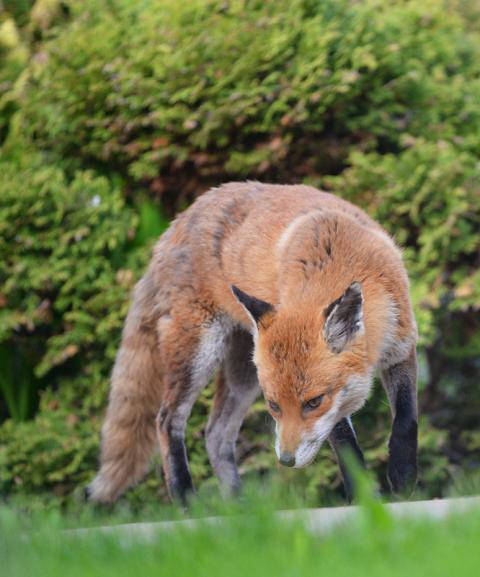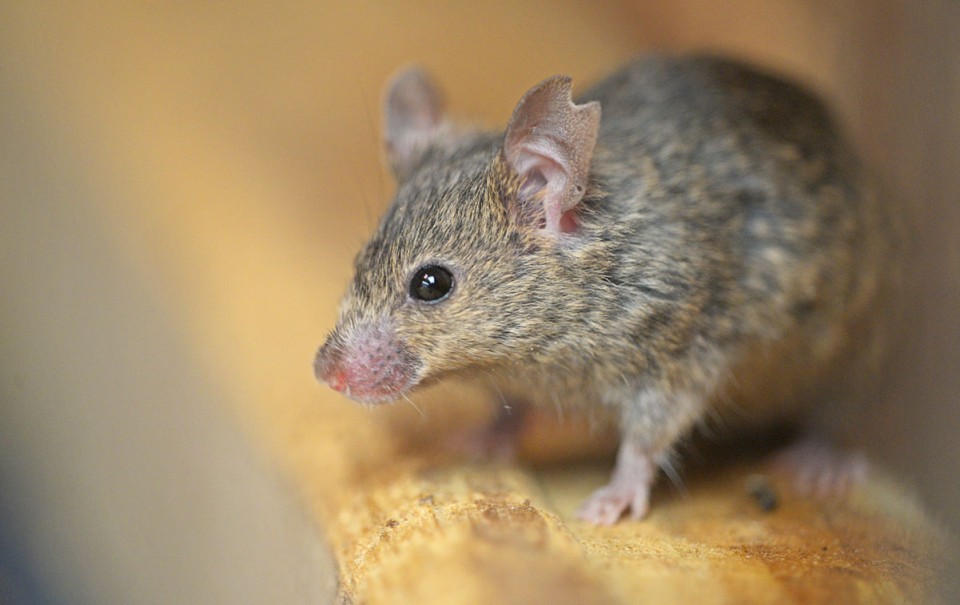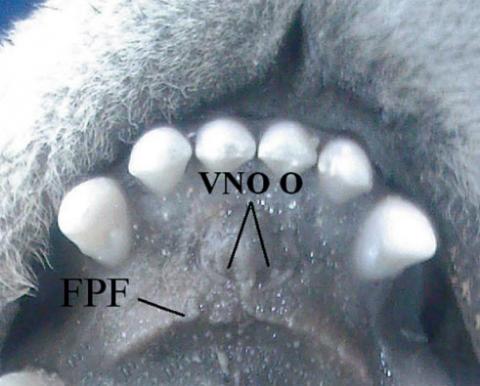Summary
In the British countryside, foxes have a smell all their own, unmistakable to the naturalist and countryperson. It's also one that many find repugnant when encountered in their garden. Fox urine in particular has a strong "skunky/musky" odour, the intensity of which varies with season and appears to be caused by two sulphur-containing compounds, Δ3-isopentenyl methyl sulfide and 2-phenylthyl methyl sulfide.
Foxes have an acute sense of smell, and scent plays a pivotal role in vulpine society. A variety of glands, producing different chemical compounds, that reflect the diversity of fox scent application. A gland on the top of the tail, near the root, known as the supracaudal or violet (named for its vaguely flowery aroma) gland, is sniffed by meeting foxes and presumably conveys individual-specific information. Glands around the chin and the angle of the jaw are employed when the fox rubs its head on the ground or mouths vegetation, while microbe-rich anal sacs either side of the anus secrete a pungent-smelling fluid onto droppings to help amplify their message.
Sebaceous glands on the feet and flanks also release scent onto the fur and into the environment. Droppings and urine are strategically deposited around the territory to declare ownership and let other individuals know who's around. In more unusual cases, urine may be employed to help keep track of caches, show cubs what's suitable to eat, and even to mark partners or other members of the social group.
Through a variety of volatile chemical signals, foxes can communicate with one another over distance and time, helping to defend territories, attract mates and manage the resources within their territory while reducing the need for direct confrontation.
Sections:
Part 1: Scent and its detection
An overview of what scents actually are, how they're produced and detected.
Part 2: The Smell of Fox - Types of scent produced by foxes
A look at the types of scent produced by Red foxes, including their urine, faeces, anal and violet glands.
Part 3: You talkin' to me? How foxes use scent
How, when and where foxes apply scent.
Part 1: Scent and its detection

"Why are foxes so smelly?" was a question sent into the BBC's Springwatch programme in 2011. It was a year in which presenter Liz Bonnin was following the fortunes of a fox family on a rubbish tip in Essex. Liz Bonnin attempted an answer, explaining that scent was a good way for these largely solitary carnivores to communicate with each remotely. This is true, but I think it also skips over a large part of what is actually a much more interesting answer.
Foxes have a smell all their own. Indeed, one of my favourite mammal-related quotes comes from William Teagle who, in his comprehensive review of the fox in the London suburbs in 1967, wrote:
"Their smell is unmistakable, once learned, never forgotten, and a mammalogist searching for Foxes uses his nose as much as an ornithologists uses his ears."
Teagle's right - it's a smell many of us recognise instantly. It has no direct parallel to my nose, although perhaps the closest comparison I have come across is one likening the smell of fox to that of a freshly opened jar of coffee. (Perhaps this says more about me as a tea-drinker than a flavour connoisseur.) It's a strong and musky scent that seems to linger long after the fox has passed; its protracted half-life in fields and woodlands allows hounds to track foxes. Teagle also provided an example of this:
"I bottled some Fox-scented sawdust in a screw-top honey jar in 1962, and at the time of writing (February, 1967) the smell retains much of its original quality."
Before we can understand how foxes employ scent, we need to take a brief look at what scent actually is and how it is both produced and detected.
What is scent?
The origin of the word, from the fourteenth century French sentir -- meaning "to perceive", "to feel", "to smell", depending on context -- hints at the answer to this question. The Merriam-Webster dictionary defines scent as:
"effluvia from a substance that affect the sense of smell: as a: an odor left by an animal on a surface passed over b: a characteristic or particular odor; especially: one that is agreeable"

In other words, it's something given off (emitted) by an object or substance that triggers our sense of smell. In most cases the noun "scent" is applied to pleasant smells, fragrances for example, but like most of the elements that act on our senses it is highly subjective - what smells nice to me might be repulsive to you. I don't intend to delve too deeply into the biochemistry of scents and scent production, but there are a couple of aspects that we need to be familiar with before we look at how foxes use scent.
Specifically what we mean by "something", or effluvia, is a stream of tiny organic molecules whose low molecular weight allows them to leave the substance they're produced or deposited in and drift into the atmosphere.
To give some context regarding size, a single grain of rice weighs as much as nearly 16 quintillion (i.e., 15.718) molecules of 2-acetyl-1-pyrroline, a chemical that gives popcorn and basmati rice (and, as it turns out, binturongs) their distinctive smell. We call these molecules, with the ability to vapourise into a gas, volatile. Think of it like steam rising from a hot bath, filling the bathroom. Granted, we can see steam (thanks to the coalescence of water molecules into droplets that have a different refractive index to air, if you're interested), while we can't see scent (indeed, any molecule) with the naked eye because they're so small that they don't interact with light; but you get the general idea.

Scent can be released into the environment incidentally or deliberately. As we travel around, we humans leave a scent trail in our wake, on objects we've encountered - something that's used with great success by police tracker or mountain/disaster rescue dogs. We don't intend to leave our scent all over the place - it just happens. Deliberate deposition of scent, by contrast, typically involves animals or plants opening specialised structures called glands or sacs, with the aim of allowing a scent-laden liquid to escape or vapourise directly from the chamber. Many plants do this to attract pollinating insects. In most cases with animals, these deliberately released scents are intended either to leave a message for, or directly affect the behaviour of, others of the same species (conspecifics). We call these scents pheromones, from the Greek meaning "to carry a hormone". Queen honey bees, for example, release a pheromone into the colony to coordinate the activities of the workers, while the males of several species of moth follow pheromone trails released by females when they're ready to mate.
Deposition of pheromones in the environment is only really an effective way of communicating with others if it's done in the right place. Placing the "advertisement" on a path that nobody uses or in a place where it can be easily overlooked is a waste of time and effort. As such, animals that use pheromones to convey specific messages deliberately place them in areas where other members of their own species are likely to find them. We call this scent marking. In other words, scent marking is the deposition of secretions/excretions, either on objects in the environment or on other members of the same species, that contain information about the depositor and can be detected and interpreted by conspecifics.
That scent marks can be located and "read" by conspecifics makes sense in evolutionary terms, particularly in those animals that range over wide areas and may not see members of their own species very often. At the same time, however, it can be a risky strategy if your scent mark is hijacked.

We know predators often use the scent of prey to track them down, while the scent of predators causes prey species to be more cautious. In a paper to the journal Nature in 2007, for example, Ko Kobayakawa and colleagues demonstrated that trimethylthiazoline, a component of fox droppings, caused their laboratory mice to freeze and display anxious behaviour, despite having been bred in captivity and never having encountered a fox before. Observations such as these suggest that recognition of some scent is innate. Perhaps more importantly, it's also highly sensitive. We now know that rats can detect traces of trimethylthiazoline at picogram concentrations - that's at the one-trillionth of a gram level.
So, if even small quantities of scent left by animals can be "intercepted" and used by a predator to find its prey, or by prey to avoid a predator, scent marking is an inherently risky strategy, implying that there's a strong evolutionary driver behind the behaviour.
Kicking up a stink: The production and detection of scent
Animals produce scent in various ways, but typically it's a result of bacterial activity, specifically the incomplete oxidation of a biological substrate (an oil, for example) by anaerobic microbial processes. In humans, for example, apocrine glands in our skins secrete a fluid rich in protein and fat called sweat. Bacteria living on our skin feed on this sweat and release various unpleasant smelling compounds with long names (hydroxylated branched fatty acids, sulfanylalkanols and so forth), which we refer to as "B.O.". This is where the external anatomical structures of mammals come in particularly handy, as these pits, pockets and pouches hinder air movement and maintain a warm, moist environment that's ideal for the growth of bacteria. It's no coincidence that it's our crevices (armpits, groin, etc.) that tend to smell the most.

For a scent to be detected, it must reach a receptor that recognises it. In the case of mammals this is one of two places: a special organ in the roof of the mouth called the vomeronasal organ (VNO), or the nose.
The VNO, sometimes also referred to as the Jacobson's organ after the Danish surgeon who wrote about it in 1813, is a small bulb of tissue forming part of the nasopalatine duct that runs along the roof of the mouth. It is divided by the nasal septum, meaning there are two openings about 5mm apart, one either side of the nasopalatine duct. The connection to the mouth is next to the first palatine fold and is via the incisive papilla, a small bump on the roof of the mouth about 3mm behind the incisors, while the other end feeds ultimately into the hypothalamus. An anatomical study of this organ in Iranian red foxes by Hamid Karimi and colleagues found it to be about 17mm (0.7 in.) long and 0.2mm wide and, based on the tissue present, suggests it's particularly sensitive to pheromones. Going by observations in domestic dogs and cats, and very recently in an adult dog fox on Adele Brand's trailcam, sampling by this gland may be associated with a chattering of the lower jaw, which perhaps helps force the scent into the incisive papilla.
For the purposes of this article, it's the nose that we're particularly interested in. Scent can reach it in two ways: the nose can come to the odorous substance (i.e., directly sniffing a scent mark), or the odorous substance can be carried on the air to the nose. Which of these happens will depend heavily on the chemical structure of the scents being deposited, with those that aren't prone to vaporising ("evaporating") less likely to reach a twitching nose on the wind. Indeed, Peter Apps and colleagues, in their 2015 review of vertebrate chemical signals, concluded that signal compounds with high molecular weights and low vapour pressures, or those that are bound to carrier proteins and are hence less prone to vaporising, are invariably detected during direct contact with the source of the signal.
Gotta get a message to you

We'll come to some of the specifics of the scents foxes produce and how they're generated shortly, but regardless of the signal compounds manufactured, a crucial part of any scent mark is its longevity - does it hang around long enough for others to read it? A scent that dissipates within a few minutes has limited biological use and, consequently, mammals have evolved mechanisms to help stabilise these scent marks, or, more accurately, to help reduce their volatility. In particular, mammals have specialised glands in their skin called sebaceous glands that produce a waxy secretion called sebum; this is the scourge of acne-afflicted teenagers, who produce it in excess during puberty, because it blocks pores. The specific composition of sebum varies considerably species to species, but in all mammals it's largely lipid (fat)-based and its primary function is to condition our skin and hair, lubricating it and making it waterproof.
As well as protecting the skin, sebum acts as a convenient "paste" in which scent can be deposited on a surface, and also seems to help reduce the volatility of the scent components, thereby prolonging the residence time of the scent mark. In other words, sebum acts as a "vehicle" to transport and sustain volatiles - to get them out of the body and help the smell to last longer once it's out. The pharaohs of Ancient Egypt mixed plant-based fragrances with oils to make sweet-smelling essential oils and waxy ointments some 3,000 years ago, suggesting that fat has been a recognised carrier of volatile substances for centuries.
Precisely how natural waxes and oils slow down the release of volatile substances is a complicated topic, well beyond the scope of this article and my understanding as a non-chemist. Suffice to say, as described to me by Jonathan Burley, Assistant Professor in Pharmaceutical Nanotechnology at Nottingham University, these lipids probably interact with scent molecules in various ways, including a simple "locking away" (i.e., a direct binding and holding of them in the wax), a disordering of molecules, and some weak interactions between the scent and carrier to slow down their movement. Molecules need energy to break free from their carrier; slow them down (i.e., reduce that energy) and it takes them longer to build up the momentum needed to escape. Ergo, the secretion of scents in these sebaceous secretions retards the scent release, providing a continuous release over a long period.

If mixing scent molecules with lipids affects their release, then the types of molecules and lipids may affect the overall scent produced, implying the possibility that I smell different from you, for example, despite us both being humans. Indeed, in his series of papers on skin lipids published in Science in 1974, University of Southern California dermatologist Nicholas Nicolaides suggested that skin waxes may have a role to play in individual olfactory communication (as well as conditioning skin and inhibiting microbial growth) because individuals vary considerably in their wax synthesis and biochemistry. Thirty-four years later, writing in Experimental Dermatology, Christos Zouboulis and his colleagues built on Nicolaides' hunch, suggesting it may encode information about the health and status of an individual:
"In this concert of odours, sebum may function as a finely tuned dosage unit that provides putative sexual partners with information about the status of the immune system, building the basis for a well-equipped offspring"
You've got mail
Getting your "message" out there is only half the battle - someone else needs to be able to read and understand it, and mammals have evolved a complex olfactory system to do just this.
When we sniff at something, scent molecules (odorants) are carried on a stream of air into the nasal cavity where they're "captured" by specialised cells called olfactory receptors. When triggered by a molecule they send an electrical signal to an area of the brain known as the olfactory bulb. Olfactory receptors are embedded in a layer of tissue that lines the nasal cavity called the olfactory epithelium mucosa, and it's generally considered that the larger the surface area of this mucosa, the more sensitive the owner's sense of smell is because the more receptors there are. There are also tiny hair-like structures called cilia that help increase the surface area further and "catch" scent molecules. With that in mind, mammals, and carnivorans in particular, have evolved highly convoluted sinuses, allowing a vast surface area for the mucosa to line.

Peer up the nose of a fox skull and you'll see a fine latticework of bones called nasal turbinates or turbinals. This network of bone serves several functions. They allow conditioning of the air, warming and moistening inhaled air so as not to "shock" the lungs and condensing exhaled air to reduce water loss, preventing the lungs drying out during exercise. For our purposes, though, they also slow down the airflow. I'm not aware of any airflow modelling studies for foxes, but we know that in domestic dogs the turbinals result in a slower and smoother flow in the recesses of the cavity, allowing more time for receptors to "catch" scent molecules. In their chapter in T.H. Park's Bioelectronic Nose, Ruchira Sharma and Hiroaki Matsunami point out that receptors can be broadly or narrowly "tuned". In other words, they can be activated by various different molecules or by only one. Add to this that a given scent molecule may excite several different receptors and it's clear that the olfactory system can detect and discriminate among tens of thousands of odorants.
In his paper to the Journal of Anatomy in 2012, UCLA biologist Patrick Green and colleagues presented various olfactory measurements for several carnivoran species. From their red fox skulls, they calculated that the presence of turbinals allowed dog foxes an olfactory mucosa of about 456 sq-cm (70 sq-in), while vixens accommodated 396 sq-cm (61 sq-in). To put that in context, in the case of the dog fox, that's roughly equivalent to a mucosa the size of a mouse mat inside a snout that's no more than 6cm (just under 2.5 inches) long. Moreover, when they compared the area given over to respiratory functions (i.e., conditioning the air, slowing its flow, etc.) to that devoted to detecting scent molecules, the latter accounted for 78% of the space in the dog and 84% in the vixen.
Added to the foregoing are John Gittleman's findings, published in the Journal of Zoology in 1991, that the red fox has an olfactory bulb volume of about eight cubic centimetres (about half a cubic inch). This may not sound like much, but when we consider that an adult fox's brain is only around 44 cubic cm (2.7 cubic in.), their olfactory bulb makes up about 18% of the total brain volume - in humans, it's closer to 0.5%. Taken together, it's reasonable to conclude that foxes have a good sense of smell and, ostensibly, that smell is an important part of their ecology.
Part 2 - The Smell of Fox: Types of scent produced by foxes >